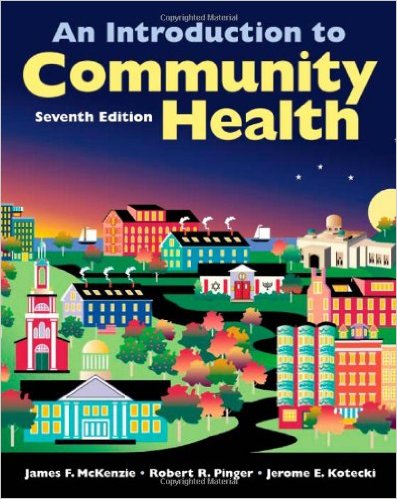Test Bank For An Introduction To Community Health 7th Edition By James F Robert R
Digital item No Waiting Time Instant DownloadISBN-13: 978-0763790110 ISBN-10: 0763790117
In Stock
Original price was: $55.00.$22.00Current price is: $22.00.
Test Bank For An Introduction To Community Health 7th Edition By James F Robert R
Chapter: Chapter03 True/False
1. A primary care physician is concerned with the course of a disease in an individual, while an epidemiologist is concerned with the course of disease in a population.
Ans: True
Page: 63
2. An unexpectedly large number of cases of an illness, specific health-related behavior, or other health-related event in a particular population defines a pandemic.
Ans: False
Page: 64
3. An endemic disease is one that occurs regularly in a population as a matter of course.
Ans: True
Page: 64
4. People afflicted with a disease are referred to as cases.
Ans: True
Page: 66
5. The rate of an illness in a population is the natality rate.
Ans: False
Page: 66
6. A disease that lasts three months or less is a chronic disease.
Ans: False
Page: 67
7. An attack rate is an incidence rate calculated for a particular population for a single disease outbreak and is expressed as a percentage.
Ans: True
Page: 68
8. The electronic reporting system used by state health departments and the CDC to report notifiable disease is Morbidity and Mortality Weekly Report (MMWR).
Ans: False
Page: 70
9. Notifiable disease information reported to local health departments is highly accurate.
Ans: False
Page: 70
10. Sometimes notifiable diseases are not reported to the local health department because patients recover without a diagnosis being confirmed.
Ans: True
Page: 70
11. The average number of years a person from a specific cohort is projected to live from a given point in time is their life expectancy.
Ans: True
Page: 76
12. The number of years of healthy life expected, on average, in a given population is the disability-adjusted life years (DALYs).
Ans: False
Page: 78
13. Vital statistics are statistical summaries of records of major life events such as births, deaths, marriages, divorces, and infant deaths.
Ans: True
Page: 81
14. An epidemiological study aimed at testing hypotheses is a descriptive study.
Ans: False
Page: 84
15. The period between exposure to a disease and the onset of symptoms is the incubation period.
Ans: True
Page: 86
Multiple Choice
Test Bank for “An Introduction to Community Health,” 7th Edition by James F. McKenzie, Robert R. Pinger, and Denise Seabert
Overview: The 7th Edition of An Introduction to Community Health by James F. McKenzie, Robert R. Pinger, and Denise Seabert provides a comprehensive exploration of community health concepts, practices, and policies. This edition is designed to offer an updated and detailed understanding of the factors influencing community health and the strategies for promoting wellness at the community level. The accompanying test bank is a valuable resource for educators and students, offering a range of questions to assess comprehension and application of key topics.
Content Details:
- Introduction to Community Health:
- Overview: Introduces the fundamental concepts of community health, including definitions, historical development, and the role of community health professionals.
- Topics Covered: The scope of community health, the impact of social determinants on health, and the evolution of public health practices.
- Community Health Assessment:
- Overview: Focuses on methods and tools for assessing the health needs and resources of a community.
- Topics Covered: Needs assessment techniques, data collection methods, and analysis of community health indicators.
- Health Promotion and Disease Prevention:
- Overview: Explores strategies and interventions for promoting health and preventing disease within communities.
- Topics Covered: Health behavior theories, program planning and evaluation, and examples of successful health promotion programs.
- Environmental Health:
- Overview: Examines the impact of environmental factors on community health and strategies for addressing environmental health issues.
- Topics Covered: Environmental hazards, pollution control, and sustainable practices for improving environmental health.
- Epidemiology and Biostatistics:
- Overview: Provides an introduction to the principles of epidemiology and biostatistics used in community health research.
- Topics Covered: Study designs, statistical methods, and interpretation of epidemiological data.
- Healthcare Systems and Services:
- Overview: Discusses the organization and delivery of healthcare services and the role of various healthcare systems in community health.
- Topics Covered: Healthcare policy, healthcare financing, and the role of public and private healthcare providers.
- Global Health Issues:
- Overview: Addresses global health challenges and the impact of global health policies on community health.
- Topics Covered: International health organizations, global health disparities, and strategies for addressing global health crises.
- Community Health Programs and Interventions:
- Overview: Focuses on the development, implementation, and evaluation of community health programs and interventions.
- Topics Covered: Program design, funding sources, and evaluation techniques.
Test Bank Features:
- Multiple-Choice Questions: Assess knowledge of key concepts, definitions, and applications in community health.
- True/False Questions: Test understanding of fundamental principles and factual information.
- Short Answer Questions: Require detailed explanations and critical thinking about community health issues.
- Essay Questions: Provide opportunities for in-depth analysis and discussion of complex community health topics.
- Case Studies: Present real-world scenarios for students to apply theoretical knowledge and propose solutions to community health challenges.
Conclusion:
The test bank for An Introduction to Community Health, 7th Edition by James F. McKenzie, Robert R. Pinger, and Denise Seabert, is a comprehensive resource that enhances the learning experience by providing a range of question types to evaluate student understanding. It supports the textbook’s content by offering diverse assessments that help students grasp community health concepts, apply theoretical knowledge to practical situations, and prepare for careers in public health. This structured approach ensures a thorough comprehension of community health principles and practices.


Reviews
There are no reviews yet.